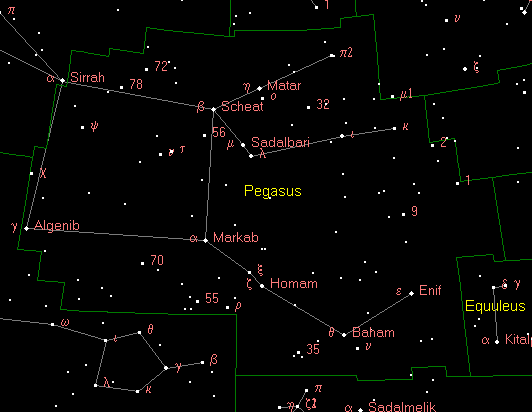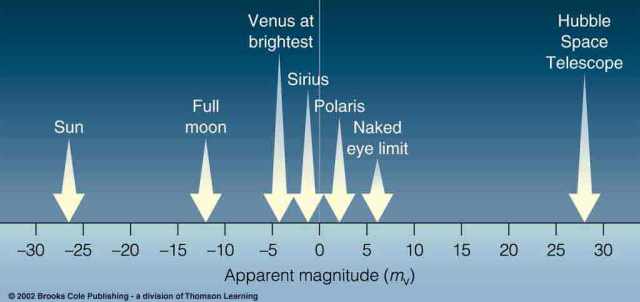
Meet Pegasus, and the constellations surrounding it. As I said in my last post, constellations are just regions of space.
Yes, they are named after mythical beasts and ancient queens, but for scientific purposes, all that matters are the regions they denote.This way, astronomers can easily find obscure, faint objects in the sky.
And telescopes can be easily programmed to find the same objects for those with less experience.
Keep in mind, though, that constellations only appear to fall in the same horizontal plane over Earth’s surface. Some of these stars, even in the same constellation, are light-years apart from one another.
So, in that case, the brighter stars must be closer to us and the dimmer stars farther away, right?
Wrong.
I know—not what you were expecting, was it? Well, like I mentioned in my last post, the brightest star in the sky is Sirius. It’s very far away from us. Proxima Centauri, on the other hand, is the nearest star to the sun…but it’s pretty dim, comparatively.
Fun Fact: Proxima Centauri is suspected to be part of a triple-star system also consisting of Alpha Centauri A and Alpha Centauri B. All three stars are gravitationally interlocked.
Proxima Centauri is the nearest of the three, making it the nearest star to the sun by a small margin.
The first thing we need to realize about stars is that they are not just pinpricks of light in the night sky. Shooting stars are about as close to being stars as are sea stars (more recent name for what were formerly “starfish.”)
We need to redefine the way we think about stars.

Think of stars as much like the sun. They are huge, exceedingly hot balls of gas whose gravity is so strong they drive their atoms to a breakneck frenzy.
I’ll talk more about stars and the way they produce heat in later posts—but for now, let’s just say that the hydrogen and helium gases that make up a star is so compressed and so excited that their atoms literally tear themselves apart.
That’s why stars are bright. They produce a ton of energy.
Anyway…because astronomers love labeling things in space, we have a way to describe the brightness of stars. Keep in mind that this only describes their apparent brightness—how they look to the human eye. Like I said, a star’s apparent brightness really has no bearing on its real brightness.
We use the magnitude scale.

This is a system that first appeared in the writings of the ancient astronomer Claudius Ptolemy. It’s likely the system actually originated earlier. Most astronomers actually attribute it to Hipparchus, a Greek astronomer.
According to the magnitude scale, stars are divided into six classes. First-class stars were the best and the brightest, just like the treatment you receive in the first class section of an airplane. And, naturally, sixth-class stars were the dimmest.
Well, actually, they were known as “first-magnitude” through “sixth-magnitude.” But I thought the class explanation made the whole backwards lay of the scale a bit simpler to understand.
I looked up first-magnitude stars on the Internet, and whadya know—I found a chart detailing the names and brightness of each one. It even cooperatively copied and pasted for me. So here you go!
| Name | Designation | Magnitude |
|---|---|---|
| Sirius | ⍺ Canis Majoris | -1.44 |
| Canopus | ⍺ Carinae | -0.62 |
| Rigil Kent or Alpha Centauri | ⍺ Rigel Kentaurus | -0.28c |
| Arcturus | ⍺ Boōtis | -0.05v |
| Vega | ⍺ Lyrae | 0.03v |
| Capella | ⍺ Aurigae | 0.08v |
| Rigel | β Orionis | 0.18v |
| Procyon | ⍺ Canis Minoris | 0.40 |
| Achernar | ⍺ Eridani | 0.45v |
| Betelgeuse or Betelgeux | ⍺ Orionis | 0.45v |
| Agena or Hadar | β Rigel Kentaurus | 0.61v |
| Altair | ⍺ Aquilae | 0.76v |
| Acrux | ⍺ Crucis | 0.77c |
| Aldebaran | ⍺ Tauri | 0.87 |
| Spica | ⍺ Virginis | 0.98v |
| Antares | ⍺ Scorpii | 1.06v |
| Pollux | β Geminorum | 1.16 |
| Fomalhaut | ⍺ Piscis Austrini | 1.17 |
| Beta Crucis | β Crucis | 1.25v |
| Deneb | ⍺ Cygni | 1.25v |
| Regulus | ⍺ Leonis | 1.36 |
Okay, so I’m guessing first-magnitude can also refer to stars whose brightness goes off the charts of Hipparchus’s system. That would explain the negative numbers. See, the fact is, there’s just too much variation in brightness in the sky to neatly group all stars under six classes.
In the modern day, astronomers use a scale numbered from -30 to 30. On this scale, the sun is -27. The full moon is at -13. When Venus is at its brightest, it measures at -5. And Sirius, the brightest star in the sky, measures at -1.47.
This is the apparent visual magnitude scale. Naturally, there’s an abbreviation for that, since I imagine it would get tedious to write out that the naked eye limit is about 6 apparent visual magnitude. We shorten it to “mv.”
So Polaris, the north star, measures at about 3 mv. The dimmest the naked eye can make out—the naked eye limit—is about 6 mv. The limit for the Hubble Space Telescope is 30 mv.
Naturally, there are dimmer stars than that, and the scale goes beyond 30 for the dim stars. But we won’t really need to talk about anything beyond 30. And there’s honestly nothing brighter than -30. You don’t get brighter than our own nearby sun.
Knowing the brightness of stars—at least their apparent brightness—helps us locate them in the sky. So, we already know how constellations help map out the sky. But how on earth can we keep all the stars straight? There’s trillions and trillions of them.
Easy. All we need to do is rank the stars by brightness within their constellations. We don’t need to worry about naming all of them. A lot of the brighter stars have Arabic names, such as Betelgeuse, Sirius, and Aldebaran. But there’s no way we can name them all.

And now you know why the stars of Orion have those peculiar little squiggles next to them in this diagram. Those are Greek letters. The stars are designated from brightest to dimmest in Greek.
So, according to the diagram above, Betelgeuse is ⍺, or alpha—meaning it’s the brightest star. Close behind is Rigel, β—or beta.
Even if you’re not familiar with the Greek alphabet—I had to learn it in sixth grade, but I never memorized the symbols—you can easily figure it out by ranking the size of the stars. This star chart has a magnitude key at the bottom that abides by the magnitude scale.
Now we know how to identify the apparent brightness of stars. But how do we refer to them by name?
Again, easy. Start with the Greek letter—you can spell it out or you can use the symbols. I thought I’d include a chart of them all for you here.

Keep in mind, when using the symbols for star designations, use the lowercase version.
After the Greek letter comes the possessive form of the constellation name. If that sounds complicated—especially given that they’re mostly in Latin—never fear, just look it up. For example, Canis Major becomes Canis Majoris.
So what would we call the brightest star of Canis Major? Alpha Canis Majoris, or ⍺ Canis Majoris.
Next up in my astronomy posts is the magnitude and intensity of stars. It’s going to be a little bit mathy, so feel free to skip it—I’m planning on releasing a post on the celestial sphere on the same day, and that’s going to be a lot more of just visual stuff.
See you guys around the galaxy!